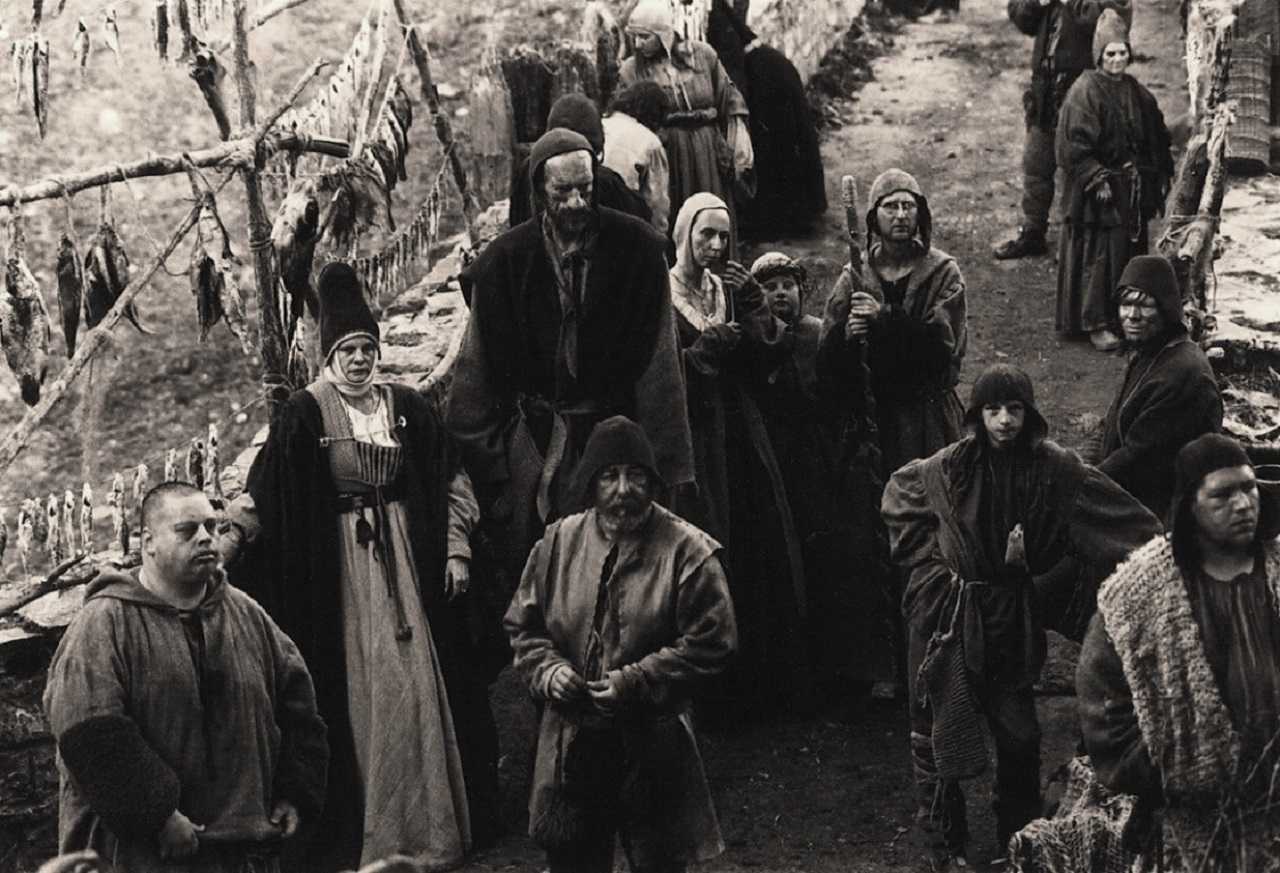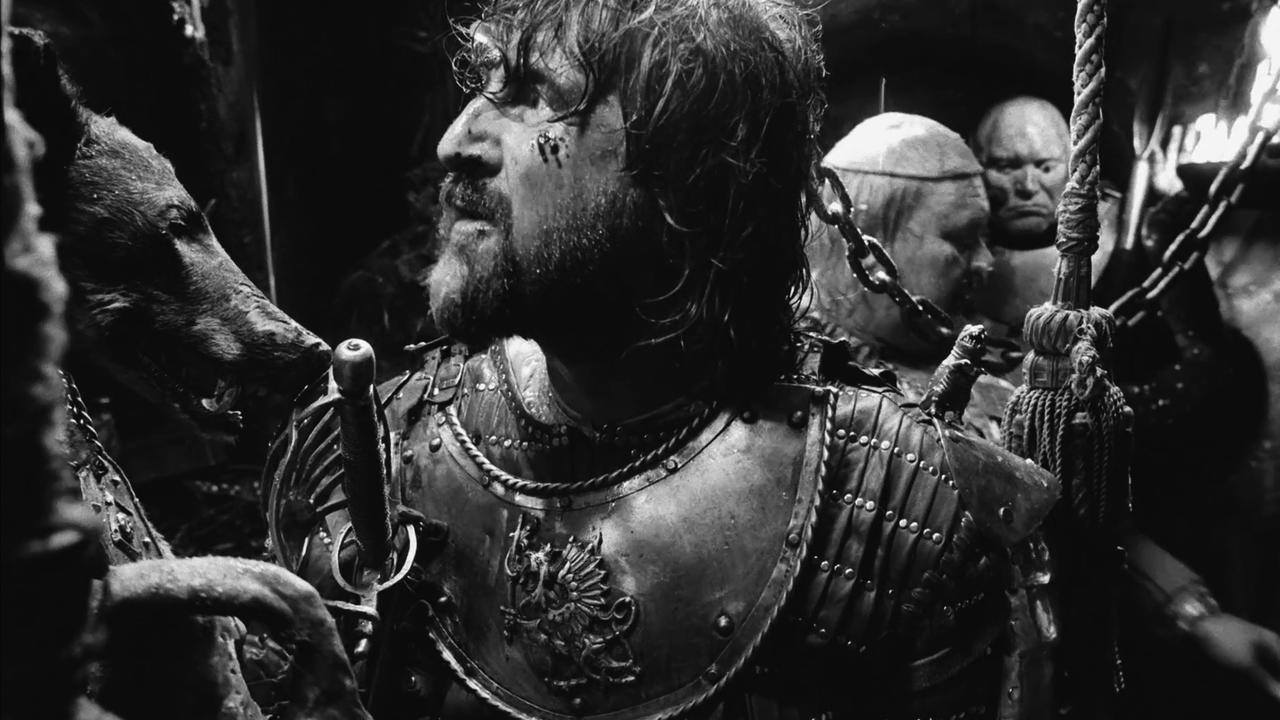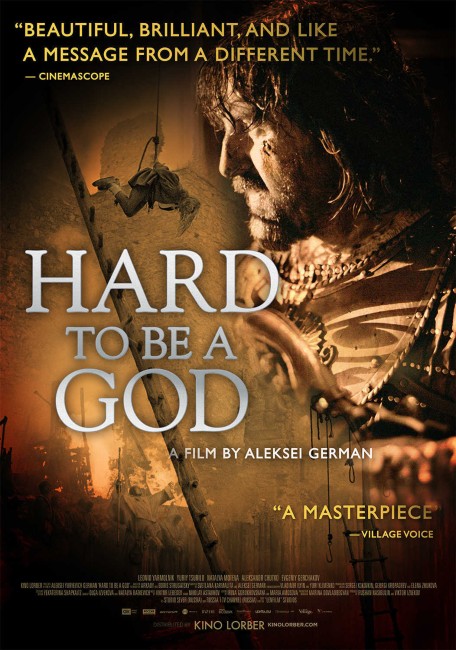(Trudno Byt Bogom)
Russia. 2013.
Crew
Director – Alexei German, Screenplay – Alexei German & Svetlana Karmalita, Based on the Novel Hard to Be a God (1964) by Arkady Strugatsky & Boris Strugatsky, Producers – Viktor Izvekov & Leonid Yarmolnik, Photography (b&w) – Vladimir Ilin & Yurly Klimenko, Music – Viktor Lebedev, Production Design – Sergei Kovovkin, Georgi Kropachyov & Elena Zhukova. Production Company – Sever Film/Lenfilm Studio
Cast
Leonid Yarmolnik (Don Rumata), Aleksandr Chutko (Don Reba), Evgeny Gerchakov (Dr Budakh), Aleksandr Ilin (Arata), Yuriy Tsurito (Don Pampa)
Plot
On a planet similar to Earth where the culture remains in the Middle Ages and has never advanced, an Earth observer has taken a disguise as the nobleman Don Rumata. As he mingles and moves among the culture of the city of Arkanar, Don Rumata is horrified at the way the Prime Minister Don Reba has begun a brutal crackdown on intellectuals and innovators.
The Strugatski Brothers, Boris and Arkady, were the most renowned science-fiction writers of the Soviet Union. Their writing career began in 1958 and lasted up until Arkady’s death in 1991. During this time, they turned out many classic works that included Snail on the Slope (1966), The Second Martian Invasion (1967), Tale of the Troika (1968), The Dead Mountaineers’ Hotel (1970) and Roadside Picnic (1972), among others. Many of their works are set in the Noon Universe, a future where humanity has spread out across the galaxy and lives in benevolent harmony along the lines of Communist principles. These have been sporadically translated into English and received acclaim, as well received a number of film adaptations. (See below for the various film adaptations of their works).
Hard to Be a God (1964) was one of the Strugatskis’ earliest novels and the one that started to gain them acclaim. This was previously filmed as the Russian/West German co-production Hard to Be a God (1989) under director Peter Fleischmann, however this was subject to creative clashes with the Strugatskis and they were not happy with the result. The 1989 film is reasonably faithful to the book – certainly, more so than this film – and it would seem that the Strugatskis’ chief issue was that they had wanted it to be made by a Russian director. This 2013 remake was seen as the version that would return to their vision.
This version of Hard to Be a God was made by Alexei German, a Russian director who had been working since the heyday of the Soviet Union. German’s films all come in the same black-and-white shot, harshly realistic style. Many of these depict life during the era of the Soviet Union and are critical of it, which had some of his earlier films banned. Hard to Be a God was apparently an enormously difficult production. German started shooting in 2000 in the Czech Republic but this was closed down and restarted several times, which caused the production process to drag out for thirteen years. German died nine months before the film eventually premiered out of competition at Cannes.

Hard to Be a God has gained a great deal of acclaim and been slapped with labels such as ‘a modern Russian masterpiece’. I have to say I am not one of the people who share these sentiments. Often criticism among the arts establishment tends to go with a groupthink that follows the lead of others who have a claimed a work and assume that because it is obscure and difficult to understand it must be brilliant. This can surely be the only reason that Hard to Be a God is attaining such plaudits.
What Hard to be a God is is a brilliant work of mise-en-scene. The whole film is shot in black-and-white and seems a depiction of the Middle Ages that is obsessively focused on the squalor, mud, blood and shit, animal carcasses, chickens running wild and the toothless and imbecilic peasantry. The tone of the film is somewhere between Andrei Tarkovski’s Andrei Rublev (1966) and the black-and-white sections of Vincent Ward’s The Navigator: A Mediaeval Odyssey (1988) that similarly regarded the Middle Ages as an alien world of frenzy, madness and filth.
To further make Hard to Be a God a baffling viewing experience, Alexei German adopts a visual style that seems to have the frame packed with half-a-dozen things all happening at once – it is almost as though the camera had been placed in the middle of a narrow corridor in which several people are all trying to pass in different directions at the same time while navigating around randomly placed objects of cryptic function. Even more bafflingly, the actors are at frequent intervals given to noticing that the camera is there, sometimes turning to and addressing it. All of this would make for a fascinating depiction of the Middle Ages. It is kind of interesting in a lunatics being allowed to take over the asylum way but the downside of it is that it comes with not the slightest thing that in any way resembles a story. The session I was at had quite a reasonable audience walk-out rate.

Furthermore, all of this has almost nothing to do with the Strugatski book. If anyone repeats the line that the 2013 film was more faithful to the book than the 1989 film, then they only display their own ignorance as not even having read the book. The book had a clear plotline. The 1989 film, for all its faults, followed this reasonably closely. Both the Strugatski novel (and 1989 film) are driven by a strong story about human observers tasked with non-involvement becoming involved in an alien culture and deciding to stand against a despot who is persecuting intellectuals and innovators.
The 2013 film, by contrast, has no plot at all. Resemblances to the Strugatski novel are passing at best. The opening narration at least tells us we are on an alien planet and there are occasional references to “back on Earth” but without this you might be hard-pressed to even regard Hard to Be a God as a science-fiction as opposed to an historical film. Without the Strugatski book to make reference to, which the film is dependent on audiences doing, you would not be able to work out that Rumata is an Earth anthropologist. His outrage at the persecutions and eventual defiance of the regime, which makes the backbone of the book, gets completely lost amid the constant caterwauling spectacle arranged in front of us.
Occasionally, Alexei German remembers to make reference to some aspect of the Strugatski book or introduce a character. Leonid Yarmolnik says he is a god a lot and talks about how hard it is to be one so as to justify the title. Mostly, we are dragged through a muddled spectacle where it is hard to work out what is happening or people are doing most of the time – before reaching an end where, after three hours, the only point of the story seems to have been to tell us that the Middle Ages was a muddy and filthy place.
The Strugatsky Brothers’ books have produced a number of film adaptations, the most famous being Andrei Tarkovsky’s loose adaptation of Roadside Picnic in Stalker (1979), along with other works such as The Dead Mountaineers’ Hotel (1979), The Sorcerers (1982), Days of Eclipse (1989), The Temptation of B. (1991), and the two-part Inhabited Island (2008) and its sequel Inhabited Island: Rebellion (2009), as well their having written the screenplay for the nuclear holocaust film Letters from a Dead Man (1986).
Trailer here


